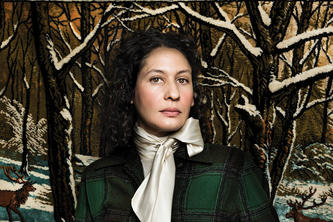
The U.S. Surgeon General recently declared loneliness an epidemic and a threat to public health, and estimates note about half of the U.S. population is experiencing loneliness. Associate Professor Carrie Henning-Smith from the University of Minnesota School of Public Health answers questions about loneliness and steps people can take if they’re experiencing it.
Q: Why is loneliness a public health issue?
Prof. Henning-Smith: Social connectedness is foundational to health — our friendships, families and other interactions greatly impact us. Humans are social creatures, meant to be in relationship with one another. If our social needs are not being met, especially over prolonged periods, our mental and physical health suffers. Loneliness is associated with a range of negative health outcomes, including cardiovascular disease, dementia, stroke and depression.
Q: What factors drive increased loneliness?
Prof. Henning-Smith: This is a complicated question without an easy answer. On one hand, loneliness has always been part of the human condition. It’s been a recurrent theme in music, literature and other art forms for as long as humans have created them. On the other hand, there are unique circumstances in our current world that heighten the risk for loneliness — the most pressing is technology. While technology has the potential to help us make connections, it can be used to limit our in-person interactions with each other, which divides and distracts us from meaningful connections.
Q: How can people experiencing loneliness address it?
Prof. Henning-Smith: It’s important to know that loneliness is common — nearly everyone will feel lonely at some point. Acknowledging how common loneliness is is an important first step in breaking down stigma and opening up meaningful conversations to address this epidemic. Reach out to others — perhaps reconnecting with someone you haven’t spoken with in a while. Research shows seeking out a new hobby or volunteering in your local community is also helpful. But — and this is really important to be clear about — it’s not just up to individuals to solve the problem of loneliness. We need to address structural barriers to social connection.
Q: Are there actions policymakers can take to break down barriers?
Prof. Henning-Smith: Yes! To address loneliness on a societal level, we need meaningful investment and policy change. This might include improvements to the built environment so spaces are safe, welcoming and accessible. It might also include ensuring everyone has access to a living wage and paid time off so they have time to socialize and be with loved ones. Policymakers could take other concrete steps, such as expanding transportation infrastructure so people can gather more easily, especially people who cannot drive or do not have access to a private vehicle.
Q: Are there differences in loneliness between rural and urban areas?
Prof. Henning-Smith: Research is somewhat mixed. There is good evidence that rural areas have stronger social cohesion than urban areas — rural residents are more likely to know, trust and count on one another than urban residents. However, rural residents face challenges to social connection, including more limited transportation options, lower incomes and poorer underlying health. In our research at the U of M’s Rural Health Research Center, we found rural older adults reported larger social networks — more close friends and family — but also higher rates of loneliness. This indicates we need to address structural barriers to connection for rural residents.
Carrie Henning-Smith is deputy director of the University of Minnesota Rural Health Research Center and an associate professor in the U of M School of Public Health. Her research seeks to advance health equity with a focus on illuminating structural and political barriers to health and well-being. She has conducted research on the impact of loneliness on health and well-being, including how social isolation affects various groups of people such as older adults and people who live in rural communities.
About the School of Public Health
The University of Minnesota School of Public Health improves the health and wellbeing of populations and communities around the world by bringing innovative research, learning, and concrete actions to today’s biggest health challenges. We prepare some of the most influential leaders in the field, and partner with health departments, communities, and policymakers to advance health equity for all. Learn more at sph.umn.edu.
About “Talking...with U of M”
“Talking...with U of M” is a resource whereby University of Minnesota faculty answer questions on current and other topics of general interest. Feel free to republish this content. If you would like to schedule an interview with the faculty member or have topics you’d like the University of Minnesota to explore for future “Talking...with U of M,” please contact University Public Relations at [email protected].
- Categories:
- Health
- Health policy




